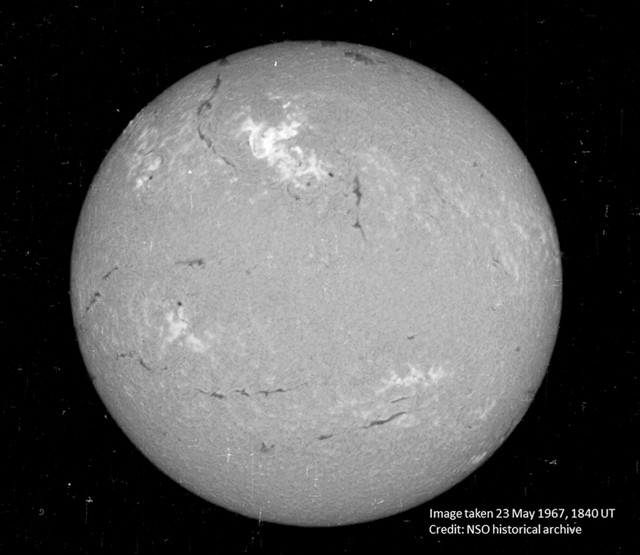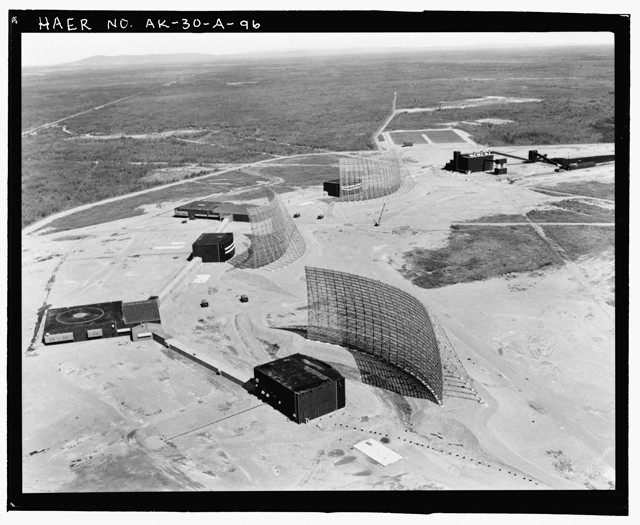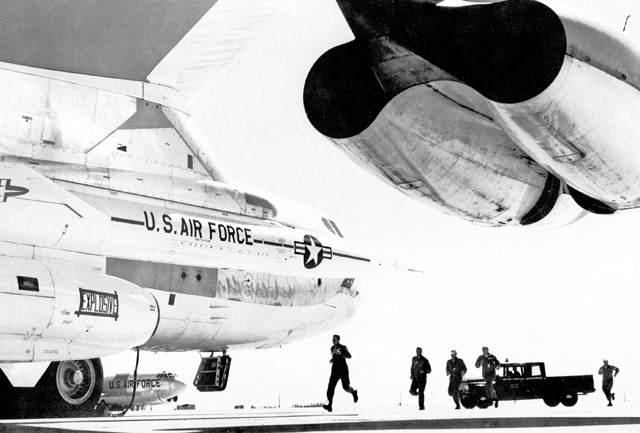
by Sara E. Pratt Thursday, April 20, 2017

The sun, on May 23, 1967, shown in a narrow visible wavelength of light called Hydrogen-alpha. The bright region (center, top) is where the May 1967 storm originated. Credit: National Solar Observatory historical archive.
By Sara Pratt
In spring 1967, international political tensions were high. The United States and the Soviet Union were engaged in the space race, as well as a nuclear arms race. The Cuban Missile Crisis, less than five years earlier, was still fresh in people’s minds. The war in Vietnam was escalating, as was the U.S. antiwar movement at home. And in the Middle East, Israel and its neighbors were on the precipice of the Six Day War.
Since the early 1960s, the U.S. Air Force’s Strategic Air Command (SAC) had kept nuclear-armed bombers airborne 24 hours a day, ready to respond to any threat. At any given time, up to half of the U.S. bomber force was on alert. Meanwhile, at three high-latitude installations of NORAD’s Ballistic Missile Early Warning System (BMEWS), radar systems continuously scanned the Arctic skies for aircraft and intercontinental ballistic missiles.
The satellite age was just beginning at this time as well, and “space weather” was still a new concept: The Army had just begun monitoring the ionosphere during World War II to try to predict when radio communications would be disrupted by solar storms. By 1967, space weather monitoring and forecasting was being done for civilians by the Environmental Science Services Administration (the forerunner of NOAA), which had begun space weather forecasting for NASA’s Gemini space mission in 1965, and for the military by the U.S. Air Force’s Air Weather Service (AWS), specifically the Fourth Weather Wing in Colorado, which had issued its first manual on forecasting solar activity less than a year earlier, in April 1966. Space weather prediction was still nascent — but an event on May 23, 1967, that nearly sent the U.S. to war brought it to the forefront and proved its worth.

A Ballistic Missile Early Warning System (BMEWS) radar site in Anderson, Alaska, in July 1962. Credit: Library of Congress.
With the BMEWS radars apparently “jammed,” at least a few bomber crews were scrambled to their planes. In the event of an attack, they had less than 15 minutes to get the planes off the ground. The disruption of radio communications also exacerbated the urgency of the situation. “Dayside radio propagation [transmission on the side of Earth facing the sun] was greatly disturbed,” Knipp says, “and dayside radio propagation was what we needed to stay in constant contact with aircraft.”
Detailed accounts of the responses at each SAC airbase do not exist, but it seems that some aircrews were dispatched as far as the runway to be at the ready, according to Knipp, who published an account of the storm and its impacts in 2016 in the journal Space Weather, of which she is editor in chief. Three of Knipp’s 10 civilian and military co-authors were personally involved in the post-event analysis.
In May 1967, the sun was on the upswing of Solar Cycle 20, and McMath Region 8818 — which was experiencing intense sunspot activity and emitting bursts of radio energy and plasma eruptions — had rotated onto the sun’s Earth-facing side on May 19. As summer was approaching, Earth’s North Pole was tilted toward the sun, meaning that solar radio emissions could “leak” into polar radar signals.
At NORAD’s AWS Solar Forecast Center at Cheyenne Mountain in Colorado, Al Snyder, the space weather forecaster on duty at the time, and his colleagues had been monitoring the situation evolving 150 million kilometers away. Solar observatories at Sacramento Peak in Sunspot, N.M., and Sagamore Hill in Hamilton, Mass., were also monitoring the sun and reporting observations to the AWS Solar Forecast Center. On May 23, in the morning briefing, Snyder noted that communications interference could arise from the high level of activity coming from a very large sunspot complex.
At about 11 a.m. Mountain Time, McMath Region 8818 produced the first of three massive flares. Within a few minutes, solar radio noise was on the rise. Approximately an hour later, radio frequency interference was so intense that the BMEWS radars were effectively jammed. Then a second flare erupted, which produced the largest recorded solar radio burst of the 20th century. “It was a solar radio disruption event that was unprecedented,” Knipp says.
But within an hour of the radar blackouts, Air Force commanders were confident — based on the reports from the forecasters and solar observatories — that the radar jamming was being caused by a solar radio burst. The forces on the ground returned to normal alert status. “We were lucky to have had the right people in the right place at the right time to understand that the sun was capable of jamming the BMEWS radars,” Knipp says.
Just how far up the chain of command those reports went isn’t known for sure, but a 1995 report on the event noted the “drastic impacts the event imparted to NORAD’s early warning systems, which have direct bearing on decisions made at the highest levels of the U.S. government.” That statement suggests that communication about the event went all the way up to the Pentagon, and possibly even to President Lyndon Johnson, Knipp says.
The impacts of the storm were felt on timescales ranging from minutes to several days. In addition to the radio burst, the sun had also emitted X-rays, extreme ultraviolet radiation, a rare white-light flare, and a coronal mass ejection that generated its own burst of energetic particles. High-frequency radio signals at high latitudes were lost as particles hit the polar ionosphere. As the geomagnetic storm began, some portions of the ionosphere were heated to more than 5,000 Kelvin and the neutral atmosphere expanded, causing drag on low-Earth orbiting satellites. The ionosphere remained greatly disturbed for days.
Today, NOAA’s Space Weather Prediction Center ranks several aspects of a solar event and its geophysical impacts felt at Earth. The rankings each range from 1 to 5, with 5 being the most extreme. On these scales, the 1967 geomagnetic storm ranked a G5, with the X-ray output ranking as an R3 and the solar radiation output an S3. The magnetospheric disturbance that hit Earth on May 25, due to the coronal mass ejection of May 23, was the eighth largest on record.
While Earth experienced record-setting geomagnetic and ionospheric storms, there were few impacts at Earth’s surface that civilians were aware of at the time. Aurorae were seen as far south as New Mexico, but other than that, not much was noted in the press. “Individual scientists studied various aspects of the May 1967 storms for years,” Knipp says, citing more than 70 published studies or technical notes that mention the storm or report data from it. “Yet somehow, the storm and its story remained obscure.”

Members of a Strategic Air Command B-52 combat crew race for their plane. In the 1960s, bomber crews were continuously ready to take off if alerted by BMEWS. Credit: U.S. Air Force photo.
Because of the 1967 storm and the impact it had on military communications, the Air Force recognized the need to include real-time space weather forecasting into its decision-making processes. “For the military, the 1967 event was a major wake-up call and led to increased awareness of the need for better predictions of solar flares and coronal mass ejections,” says Thomas Berger, director of NOAA’s Space Weather Prediction Center in Boulder, Colo. “It undoubtedly helped support the Air Force’s contention that a better solar telescope was needed at their Sacramento Peak facility.”
In the Soviet Union, Knipp says, a sudden influx of funding for space weather research and infrastructure in the late 1960s was also likely prompted by this event, according to Alexei Pevtsov, a solar physicist at the National Solar Observatory in Sunspot, N.M., with whom she spoke. Knipp also credits the storm with significantly increasing U.S. employment in the space weather field in the following years.
As the 50th anniversary of the storm passes this month, Knipp says she hopes that additional official documents will become accessible. She is also continuing her efforts to track down historical records that may exist in the archives of geophysical observatories around the world, as well as locate any scientists or military personnel who experienced the May 1967 storm, “so that the full story can be told.”
Studying such historical events can offer solar scientists rare insight, Berger says. “We’ve really only been observing the sun with scientific methods for about 150 years — a virtual blink of the eye for the sun — and we certainly have not seen the full range of solar possibilities,” he says. “The only way to get a handle on [that] is to study historical events like the 1967 storm.”
© 2008-2021. All rights reserved. Any copying, redistribution or retransmission of any of the contents of this service without the expressed written permission of the American Geosciences Institute is expressly prohibited. Click here for all copyright requests.